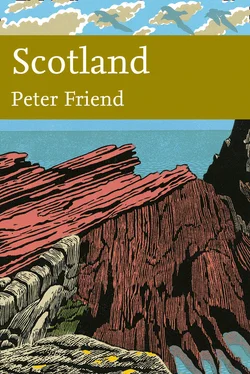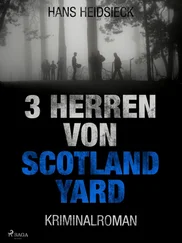FIG 32.Oxygen isotope ratios track the more than 100 climate fluctuations over the last 3.3 million years. Warm episodes (red lines above the curve) alternate with cold episodes (blue lines below the curve). These have been used as the basis for numbering the global oxygen isotope stages, as shown.
Our next step involves looking in greater detail over roughly the last 400,000 years ( Fig. 33). Over this period, there has been a distinctive pattern of increasingly highly developed 100,000-year-long cold stages, separated by 10,000-year-long warmer stages. This temperature curve (also calculated from isotope ratios) is saw-toothed in shape, representing long periods of cooling followed by rapid warming events. The most recent of the four glacial episodes covered in this diagram (the Devensian) has left abundant fresh evidence on the landscapes of Scotland and obliterated most of the evidence of the earlier ones. In this important respect, the Scottish evidence differs strongly from that of southern England, where the much earlier Anglian glacial episode has left abundant evidence of ice as far south as London. This is because later glaciations, such as the Devensian, did not reach so far south. Not surprisingly, the older evidence in southern England is not as fresh as that of the younger glaciation in Scotland.
An even closer look at the last of these cold-to-warm changes ( Fig. 34, black line) allows us to appreciate better the glaciation which has been responsible for much of the recent modification of Scottish landscapes. Starting with the Ipswichian interglacial, the Greenland curve shows fluctuations in the oxygen isotope ratios that were frequent and short-lived, though generally implying increasingly cool conditions. This part of the record is helping to define the Devensian glaciation and shows clearly the Late Glacial Maximum (LGM) at between about 30,000 and 20,000 years ago. Following this, the beginning of the Holocene warm period (about 10,000 years ago) is also clear.
FIG 33. Isotopic temperature of the atmosphere changing through the last 400,000 years, measured from ice cores taken from Vostok, Antarctica.
The link between oxygen isotopes, temperature and sea level becomes clear if we compare oxygen isotope ratios from the Greenland ice ( Fig. 34, black line) with sea-level data from tropical reefs in Papua New Guinea ( Fig. 34, red line). The data show how colder climates are generally associated with lower sea levels, reflecting the locking up of oxygen-16-rich water in land-based ice sheets during these colder times.
FIG 34. Black line: oxygen isotope ratios sampled from cores taken in the Greenland ice sheet. Red line: sea-level determinations from tropical reefs in Papua New Guinea.
At its maximum extent the Devensian ice sheet covered the whole of Scotland, including the western and northern islands. It also covered most of Wales and northern England and extended as far south as the Midlands, the Bristol Channel and the Wash. Maintaining a thickness of many hundreds of metres, it joined Norwegian ice on the Norwegian side of the northern North Sea ( Figs 35, 36).
FIG 35. One estimate of the maximum extent of the Devensian ice sheet, with generalised ice-flow directions. At a later stage the Scottish and Norwegian ice became separated.
FIG 36. West-to-east generalised cross-section at the maximum extent of the Devensian ice sheet.
FIG 37. The larger rock basins are the result of erosion by Quaternary ice streams.
There is abundant local evidence in Scotland of the modification of valleys by glaciers and ice streams, which deepened and opened out the valley profiles, removing spurs and side ridges, to produce classic U-shaped glacial troughs. These troughs are very different from the V-shaped cross-sections and sinuous forms typical of river erosion (see Fig. 8, Chapter 2). This modification work is likely to have taken place in every one of the Ice Age glacial stages that occurred in Scotland, and the same processes have also been responsible for the elongate rock basins now recognised in many offshore areas ( Fig. 37).

FIG 38. Shrinking of the main Scottish ice sheet over the last 18,000 years.
Episode 12: since the Devensian Late Glacial Maximum
The period of rather more than 20,000 years since the Late Glacial Maximum represents one of the most recent phases of intense landscape evolution ( Fig. 38). Because this was a period when ice cover was generally decreasing, local evidence is often preserved that would have been destroyed during a major phase of advancing ice. The last 10,000 years is often referred to as either the Holocene or the Flandrian Interglacial, the latter name emphasising that the ice may well return.
FIG 39. Oxygen isotope variation from (a) Greenland ice cores and (b) Northeast Atlantic sea-surface temperatures, both over the time period from 15,000 to 10,000 years BP (before present).
The record of climate change since the Late Glacial Maximum has been greatly illuminated by the same use of oxygen isotopes as described above for Episode 11. One important advantage in working on these recent times is that it is possible to seek additional, independent information for the ages of samples. Some of this dating may be based on comparison of plant remains, particularly pollen from cores extracted by drilling into lake beds or peat-rich wetlands. Other dates come from the analysis of radioactive carbon, whose rapid decay rate makes it a powerful tool in dating material that is so relatively young.
Although the dominant feature of global climate change over the past 20,000 years has been the general warming trend, detailed research has established a complex pattern of climatic fluctuations. In Scotland, the most important of these fluctuations is the Younger Dryas cold phase, also known as the Loch Lomond Stadial ( Fig. 39). During this time, between about 13,000 and 11,500 years ago, the generally retreating ice re-advanced to form an icecap covering much of the western Highlands ( Fig. 38, red line). The local effects of this Loch Lomond Advance are particularly clear within the area of western Scotland where moraines were pushed forward.
SEA-LEVEL CHANGE
In Areas with coastlines, some of the freshest features of the landscape have formed since the Late Glacial Maximum as a result of changes in sea level. Two different mechanisms have combined to produce these changes:
(1) Worldwide ocean-volume changes of the water occupying the world’s ocean basins. These have been the direct result of the locking-up or releasing of water from land-based ice sheets as they grow or shrink due to climate fluctuations. The water itself may also have expanded or contracted as its temperature changed. These worldwide processes are often grouped together as eustatic.
(2) Solid Earth local movements which have resulted in the local raising or lowering of the ground surface relative to the level of the sea. These movements were responses to changes in the local temperature or stress pattern within the Earth. Ice-sheet melting unloaded the crust of the Earth locally, resulting in uplift, while ice-sheet growth loaded the crust, resulting in subsidence. These effects are often referred to as isostatic adjustments of local sea level (see Chapters 2 and 3).
Some parts of the world, for example many tropical areas, have been free of ice since before the Late Glacial Maximum and so have avoided any solid Earth movements associated with loading and unloading by ice. Records of changing sea level from these areas can therefore be used to estimate worldwide (eustatic) changes in the volume of the world’s oceans since the Late Glacial Maximum. Figure 40shows that eustatic sea level has risen by about 120 m over the past 18,000 years, beginning with a slow, steady rise until about 12,000 years ago, followed by a rapid increase until about 6,000 years ago, and then another slow, steady phase up to the present day.
Читать дальше













